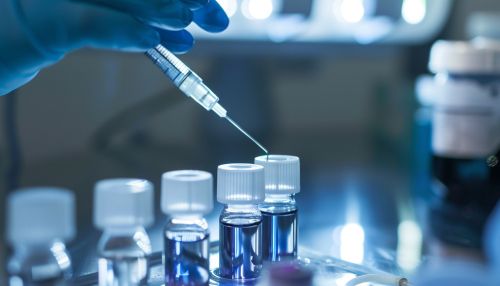Contrast agent: Difference between revisions
(Created page with "== Introduction == A contrast agent (also known as a contrast medium) is a substance used to enhance the contrast of structures or fluids within the body in medical imaging. It is commonly used to improve the visibility of blood vessels and the gastrointestinal tract. == Types of Contrast Agents == There are several types of contrast agents, each with their specific uses and properties. === Iodinated Contrast === Iodinated contrast agents are a...") |
No edit summary |
||
| Line 56: | Line 56: | ||
Research is ongoing to develop new and improved contrast agents. These include agents with fewer side effects, agents that can provide more detailed images, and agents that can target specific cells or molecules, potentially improving the diagnosis and treatment of diseases. | Research is ongoing to develop new and improved contrast agents. These include agents with fewer side effects, agents that can provide more detailed images, and agents that can target specific cells or molecules, potentially improving the diagnosis and treatment of diseases. | ||
[[Image:Detail-78827.jpg|thumb|center|A close-up of a contrast agent being prepared for use in a medical imaging procedure.|class=only_on_mobile]] | |||
[[Image:Detail-78828.jpg|thumb|center|A close-up of a contrast agent being prepared for use in a medical imaging procedure.|class=only_on_desktop]] | |||
== See Also == | == See Also == | ||
Latest revision as of 20:14, 15 May 2024
Introduction
A contrast agent (also known as a contrast medium) is a substance used to enhance the contrast of structures or fluids within the body in medical imaging. It is commonly used to improve the visibility of blood vessels and the gastrointestinal tract.
Types of Contrast Agents
There are several types of contrast agents, each with their specific uses and properties.
Iodinated Contrast
Iodinated contrast agents are among the most commonly used contrast agents, especially in radiology. These agents contain iodine, which is a high-atomic-number element that provides high radio-opacity and makes structures more visible on radiographs.
Barium Sulfate
Barium sulfate is a type of contrast agent used in X-ray imaging of the digestive system. It is a white, insoluble powder that is mixed with water and swallowed or administered by enema.
Gadolinium-Based Contrast Agents
Gadolinium-based contrast agents (GBCAs) are used in magnetic resonance imaging (MRI). Gadolinium is a rare earth metal, and when it is chelated with carrier molecules, it can provide contrast in MRIs.
Microbubble Contrast Agents
Microbubble contrast agents are used in ultrasound imaging. These agents are gas-filled bubbles that are small enough to pass through capillaries and are used to enhance the echogenicity of blood, improving the visibility of blood vessels.
Mechanism of Action
Contrast agents work by altering the way that electromagnetic waves, such as X-rays or ultrasound waves, interact with the body. Depending on the type of imaging, different contrast agents will be used.
Iodinated Contrast and Barium Sulfate
In X-ray and CT imaging, iodinated contrast and barium sulfate work by absorbing X-rays more than the surrounding tissues. This absorption causes the areas where the contrast agent is present to appear lighter on the resulting image, providing a contrast against the darker surrounding tissues.
Gadolinium-Based Contrast Agents
In MRI, gadolinium-based contrast agents work differently. Instead of absorbing electromagnetic waves, these agents affect the relaxation times of protons in the body. This results in a change in the signal intensity in the image, providing contrast.
Microbubble Contrast Agents
In ultrasound imaging, microbubble contrast agents work by reflecting the ultrasound waves back to the transducer, enhancing the echo signal. This makes the blood vessels where the microbubbles are present appear brighter on the ultrasound image.
Uses
Contrast agents are used in a variety of medical imaging procedures to help visualize structures and fluids within the body that would otherwise be difficult to see.
Radiology
In radiology, iodinated contrast and barium sulfate are used in procedures such as CT scans, X-rays, and angiography to visualize blood vessels and the gastrointestinal tract.
Magnetic Resonance Imaging
In MRI, gadolinium-based contrast agents are used to enhance the contrast between normal and abnormal tissues, making it easier to identify areas of concern.
Ultrasound Imaging
In ultrasound imaging, microbubble contrast agents are used to enhance the visibility of blood vessels, improving the detection and characterization of vascular diseases.
Safety and Risks
While contrast agents are generally safe, there are risks associated with their use. These risks can include allergic reactions, kidney damage, and in rare cases, a serious condition known as nephrogenic systemic fibrosis (NSF).
Allergic Reactions
Some people may have an allergic reaction to contrast agents, especially iodinated contrast. These reactions can range from mild symptoms such as itching and rash to more severe reactions such as difficulty breathing and low blood pressure.
Kidney Damage
Contrast-induced nephropathy (CIN) is a form of kidney damage that can occur after the administration of contrast agents. This is more common in patients with pre-existing kidney disease and in those receiving large doses of contrast.
Nephrogenic Systemic Fibrosis
Nephrogenic systemic fibrosis (NSF) is a rare but serious condition that can occur in patients with severe kidney disease who receive gadolinium-based contrast agents. This condition is characterized by the thickening and hardening of the skin and can also affect internal organs.
Future Developments
Research is ongoing to develop new and improved contrast agents. These include agents with fewer side effects, agents that can provide more detailed images, and agents that can target specific cells or molecules, potentially improving the diagnosis and treatment of diseases.


